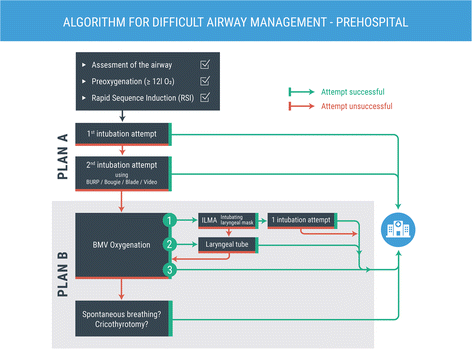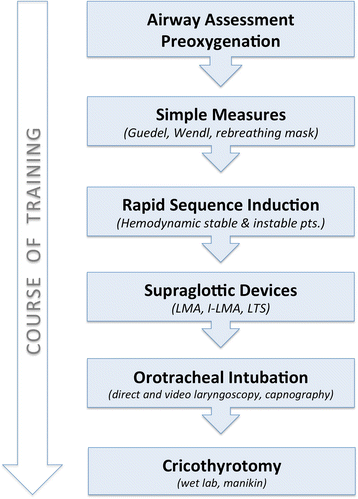Success rates of pre-hospital difficult airway management: a quality control study evaluating an in-hospital training program
- PMID: 29549460
- PMCID: PMC5856681
- DOI: 10.1186/s12245-018-0178-7
Success rates of pre-hospital difficult airway management: a quality control study evaluating an in-hospital training program
Abstract
Background: Competence in emergency airway management is key in order to improve patient safety and outcome. The scope of compulsory training for emergency physicians or paramedics is quite limited, especially in Austria. The purpose of this study was to review the difficult airway management performance of an emergency medical service (EMS) in a region that has implemented a more thorough training program than current regulations require, comprising 3 months of initial training and supervised emergency practice and 3 days/month of on-going in-hospital training as previously reported.
Methods: This is a subgroup analysis of pre-hospital airway interventions performed by non-anesthesiologist EMS physicians between 2006 and 2016. The dataset is part of a retrospective quality control study performed in the ground EMS system of Wiener Neustadt, Austria. Difficult airway missions recorded in the electronic database were matched with the hospital information system and analyzed.
Results: Nine hundred thirty-three of 23060 ground EMS patients (4%) required an airway intervention. In 48 cases, transient bag-mask-valve ventilation was sufficient, and 5 patients needed repositioning of a pre-existing tracheostomy cannula. Eight hundred thirty-six of 877 patients (95.3%) were successfully intubated within two attempts; in 3 patients, a supraglottic airway device was employed first line. Management of 41 patients with failed tracheal intubation comprised laryngeal tubes (n = 21), intubating laryngeal mask (n = 11), ongoing bag-mask-valve ventilation (n = 8), and crico-thyrotomy (n = 1). There was no cannot intubate/cannot ventilate situation. Blood gas analysis at admission revealed hypoxemia in 2 and/or hypercapnia in 11 cases.
Conclusion: During the 11-year study period, difficult airways were encountered in 5% but sufficiently managed in all patients. Thus, the training regime presented might be a feasible and beneficial model for training of non-anesthesiologist emergency physicians as well as paramedics.
Keywords: Airway management; Austria; Bag-mask-valve ventilation; Crico-thyrotomy; Difficult airway algorithm; Emergency physician; Prehospital care; Supraglottic airway; Tracheal intubation.
Conflict of interest statement
Competing interests
All authors declare that they have no competing interests.
Publisher’s Note
Springer Nature remains neutral with regard to jurisdictional claims in published maps and institutional affiliations.
Figures
Similar articles
-
In-hospital airway management training for non-anesthesiologist EMS physicians: a descriptive quality control study.Scand J Trauma Resusc Emerg Med. 2017 Apr 26;25(1):45. doi: 10.1186/s13049-017-0386-9. Scand J Trauma Resusc Emerg Med. 2017. PMID: 28441963 Free PMC article.
-
Supraglottic airway device versus tracheal intubation in the initial airway management of out-of-hospital cardiac arrest: the AIRWAYS-2 cluster RCT.Health Technol Assess. 2022 Apr;26(21):1-158. doi: 10.3310/VHOH9034. Health Technol Assess. 2022. PMID: 35426781 Free PMC article. Clinical Trial.
-
Role of anesthesiology curriculum in improving bag-mask ventilation and intubation success rates of emergency medicine residents: a prospective descriptive study.BMC Emerg Med. 2011 Jun 16;11:8. doi: 10.1186/1471-227X-11-8. BMC Emerg Med. 2011. PMID: 21676271 Free PMC article.
-
Anaesthesia in prehospital emergencies and in the emergency room.Resuscitation. 2010 Feb;81(2):148-54. doi: 10.1016/j.resuscitation.2009.10.023. Epub 2009 Nov 25. Resuscitation. 2010. PMID: 19942337 Review.
-
Anesthesia in prehospital emergencies and in the emergency department.Curr Opin Anaesthesiol. 2010 Aug;23(4):500-6. doi: 10.1097/ACO.0b013e32833bc135. Curr Opin Anaesthesiol. 2010. PMID: 20543679 Review.
Cited by
-
[Airway management in preclinical emergency anesthesia with respect to specialty and education].Anaesthesist. 2020 Mar;69(3):170-182. doi: 10.1007/s00101-020-00737-2. Epub 2020 Feb 13. Anaesthesist. 2020. PMID: 32055885 German.
References
-
- Wang HE, Davis DP, Wayne MA, Delbridge T. Prehospital rapid-sequence intubation-what does the evidence show? 2004. pp. 366–377. - PubMed
LinkOut - more resources
Full Text Sources
Other Literature Sources



